
A new bioprinting technique developed at the Vienna University of Technology in Austria can integrate living cells into fine structures created in a 3D printer.
Using a high-resolution bioprinting process with a new "bio ink" for the 3D printer, cells can now be embedded in a 3D matrix printed with micrometer precision at a printing speed of 1 m/sec. That is an order of magnitude faster than previously possible, according to the researchers.
A team of authors led by Aleksandr Ovsianikov, PhD, head of the 3D printing and biofabrication research group at the Institute of Materials Science and Technology, shared the new method in an article published online July 26 in Advanced Healthcare Materials. In addition, the technology and materials are being commercialized by a Vienna University of Technology spin-off called UPNano.



















